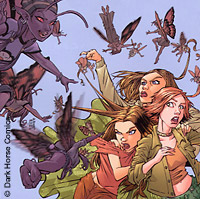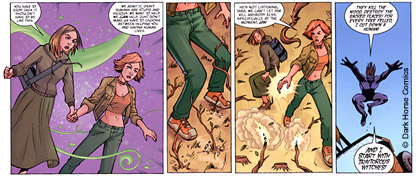



















"The Innocent", written by her and drawn and inked by Ted Naifeh, is part of the "Tales of the Slayers" cycle which extends Joss Whedon’s Slayer mythology (you know the drill: "In every generation, there is a chosen one – one girl in all the world to fight dental floss, corporate capitalism and bad manners, and oh god isn’t it just awful to watch all that infertile 'debate' by so-called fans on the internet who pick their favorite writers or actors by force of whim and then set them against each other in grand imaginary battles, relying for inspiration on gossip and other unkind sources fit only for those unbalanced enough to find some ugly joy in disingeniously exploiting the utterly normal yet unfortunate frictions any working environment creates, and isn’t it just afwul as well how these people seem to almost deliberately try to destroy fond memories of a unique artistic experience, namely a television show that actually, just this one time, did not suck molten lead through an iron straw, oh dear, he’s not talking about 'Buffy' again, is he? and so on and so forth…") over several centuries into both the past and the future. Amber’s short story is a period piece set in revolutionary France and manages – on a mere eight pages – to tell a poignant tale about revenge, loss, class struggle, trust, betrayal and the kind of vampire that doesn’t explode into greenish dust when you stake them. Think "A Tale of Two Cities" crossed with "Near Dark" or Bram Stoker writing an "Angel"-flashback scene after having read Carlyle. The "Tales of the Slayers" paperback by Dark Horse in which you can find this cool story also has some better-than-average stuff by a bunch of the best writers of the show, inculding Whedon himself, David Fury and Jane Espenson, and features artwork by P. Craig Russel as well as the legendary guy who practically re-created Dracula for the comic book format, the great Gene Colan.
Moving right along, there’s two "Willow & Tara" books featuring Amber’s work, the second of which is actually a two-parter, but let’s ignore arithmetic and call them two books, not three, OK?
Amber’s collaborator on both "W&T"-books is Christopher Golden, with whom she also did the "Ghosts of Albion"-Project for the BBC an is going to do not one but two novels set in the same world for Del Rey Publishers. Golden, besides having written numerous genre books and a series of teenage thrillers and being both a seasoned pop culture journalist and comic book author, wrote not one but several Buffy-related books (one of those, "Immortal", which he co-wrote with Nancy Holder, also came out as an audio-book, read by Charisma "Cordelia Chase" Carpenter). I’ve read four of his books so far and liked them all, especially the delightful historical Spike-&-Drusilla-caper "Pretty Maids all in a Row" and the 4-Part-"Lost Slayer"-Alternate Universe-series. These display a fine sense of what makes Whedon’s larger-than-yet-also-true-to-life-characters tick, some nice pacing & storytelling (what you academics like to call a "vigorous diegetic intelligence") and ample knowledge about the genre or genres they touch upon: the "Lost Slayer"-series, for instance, cleverly plays with the Dickens/King("Green Mile")-Serialization challenge and the construction of a narrative frame, while another of Golden’s Buffy novels called "The Widsom of War" gets the Lovecraft idiom right by not imitating it but rather translating it for the Buffyverse, and also uses Faith almost as true-to-voice as Ms. Holder does in her very fast and entertaining "Book of Fours".
Whenever Golden writes Tara, the prose gets sweet (not saccharine) and touching and thoughtful and … well, you know Tara? It’s her.

The Willow-and-Tara comic books feel somewhat different from the novels, though. I like one ("Wilderness") better than the other ("Wannadblessedbe"). The reason for this is probably one of purely personal taste.
The one-shot "Wannablessedbe" was drawn by Terry Moore, creator of indie success "Strangers in Paradise", which also features a lesbian couple – his quasi-realistic style of rendering the characters turns out to be less effective, at least for me, than AJ’s pencils and Derek Fridolfs’ inks on "Wildernes", which are far more cartoony, more abstract and (therefore?) more stylish.
Of course, the characters do not have to be established, we know them, for they have been played on TV by exceptional acting talents.
But when you make them look like Terry Moore’s creations, his literary characters, which he cannot help but do – I don’t mean the likenesses as such, but the feel of the pictures, the linework, perspective etc. – they immediately, to my mind, start to feel like something made for paper, and that takes something away from them, at least to my tastes. When you make them look like lovingly rendered caricature versions, on the other hand, as the artists on "Wilderness" do, the whole thing becomes sort of quirky, lively and animated, and the reader never gets distracted by the likeness/non-likeness issue. This, then, allows you to "listen" to the characters’ voices more clearly, I suppose, and that’s what ultimately makes "Wilderness" a success.
Amber Beson and Christopher Golden know how to write one of the most romantic, most believable, most affecting couples in Genre TV history (actually, that’s probably damning the W/T-relationship with faint praise, but let it slide) with an understated sureness that never distracts from the adventure at hand.
The Story of "Wannablessedbe" concerns a young girl dabbling with the occult and getting herself in trouble for trying to out-witch the other wiccans. One could say she’s a more benign model of the "Amy"-series, and the way she learns her lesson is narrated briskly while thoroughly avoiding preachiness. It seems that this book was sort of a rehearsal, though, for "Wilderness" gets far more elaborate: W & T kind of save (the heart of) a forest, fight a tolkienesque raging-Hippie-spirit-of-the-walking-Tree-kinda-thing, get Dawn safely out of harm’s way, grab or hold each others hands some of the time as we like them to, allude mildly to shared kinkiness and show traces of behaviour that in the show tends to evolve into something more passionate and sinister (Willow threatening magical creatures who in turn threaten Tara to "kill you all", for example).
The hard-to-come-by original edition of "Wannablessedbe" came with a smart afterword/essay by Amber Benson re: being a girl and therefore feeling/being excluded from the rather nerdy comic book-environment followed by a reflection on how it feels to finally discover the comic book as a suitable playground for her excellent creative mind. The second part of the two-book-"Wilderness"-tale had a nice "Firefly"-ad in it which feels quite melancholy to look at at this moment.
You can get all W/T-comic books discussed here, plus Amber’s essay, in one volume by buying the "Willow and Tara"-Paperback by Dark Horse, and you should.
Dietmar Dath
> back to top


